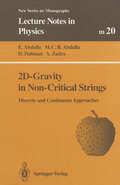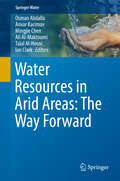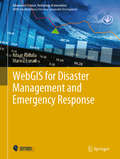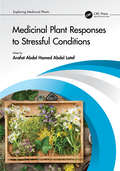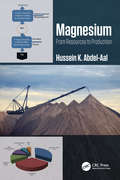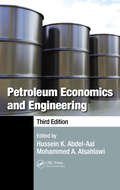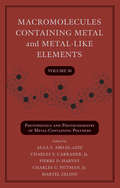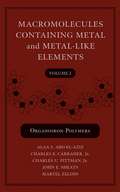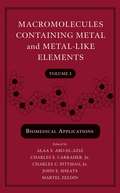- Table View
- List View
Optical and Wireless Convergence for 5G Networks (Wiley - IEEE)
by Abdelgader M. Abdalla Issa Elfergani Jonathan Rodriguez Antonio TeixeiraThe mobile market has experienced unprecedented growth over the last few decades. Consumer trends have shifted towards mobile internet services supported by 3G and 4G networks worldwide. Inherent to existing networks are problems such as lack of spectrum, high energy consumption, and inter-cell interference. These limitations have led to the emergence of 5G technology. It is clear that any 5G system will integrate optical communications, which is already a mainstay of wide area networks. Using an optical core to route 5G data raises significant questions of how wireless and optical can coexist in synergy to provide smooth, end-to-end communication pathways. Optical and Wireless Convergence for 5G Networks explores new emerging technologies, concepts, and approaches for seamlessly integrating optical-wireless for 5G and beyond. Considering both fronthaul and backhaul perspectives, this timely book provides insights on managing an ecosystem of mixed and multiple access network communications focused on optical-wireless convergence. Topics include Fiber–Wireless (FiWi), Hybrid Fiber-Wireless (HFW), Visible Light Communication (VLC), 5G optical sensing technologies, approaches to real-time IoT applications, Tactile Internet, Fog Computing (FC), Network Functions Virtualization (NFV), Software-Defined Networking (SDN), and many others. This book aims to provide an inclusive survey of 5G optical-wireless requirements, architecture developments, and technological solutions.
2D-Gravity in Non-Critical Strings: Discrete and Continuum Approaches (Lecture Notes in Physics Monographs #20)
by E. Abdalla M.C.B. Abdalla D. Dalmazi A. ZadraA comprehensive survey of the use of the Liouville (and super-Liouville) equation in (super)string theory outside the critical dimension, and of the complementary approach based on the discretized space-time - known as the matrix model approach. The authors pay particular attention to supersymmetry, both in the continuum formulation and through the consideration of the super-eigenvalue problem. The methods presented here are important in a large number of complex problems, e.g. random surfaces, 2-D gravity and large-N quantum chromodynamics, and this comparitive study of the different methods permits a cross-evaluation of the results when both methods are valid, combined with new predictions when only one of the methods may be applied.
Water Resources in Arid Areas: The Way Forward (Springer Water)
by Osman Abdalla Anvar Kacimov Mingjie Chen Ali Al-Maktoumi Talal Al-Hosni Ian ClarkThis book presents the most recent innovations, trends, concerns and practical challenges, and solutions in the field of water resources for arid areas. It gathers outstanding contributions presented at the International Water Conference on Water Resources in Arid Areas (IWC 2016), which was held in Muscat, Oman in March 2016. The individual papers discuss challenges and solutions to alleviate water resource scarcity in arid areas, including water resources management, the introduction of modern irrigation systems, natural groundwater recharge, construction of dams for artificial recharge, use of treated wastewater, and desalination technologies. As such, the book provides a platform for the exchange of recent advances in water resources science and research, which are essential to improving the critical water situation
WebGIS for Disaster Management and Emergency Response (Advances in Science, Technology & Innovation)
by Rifaat Abdalla Marwa EsmailThis book aims to help students, researchers and policy makers understand the latest research and development trends in the application of WebGIS for Disaster Management and Emergency Response. It is designed as a useful tool to better assess the mechanisms for planning, response and mitigation of the impact of disaster scenarios at the local, regional or national levels. It contains details on how to use WebGIS to solve real-world problems associated with Disaster Management Scenarios for the long-term sustainability. The book broadens the reader understanding of the policy and decision-making issues related to Disaster Management response and planning.
Applied Mathematics and Omics to Assess Crop Genetic Resources for Climate Change Adaptive Traits
by Abdallah Bari, Ardeshir B. Damania, Michael Mackay and Selvadurai DayanandanApplied Mathematics and Omics to Assess Crop Genetic Resources for Climate Change Adaptive Traits focuses on practical means and approaches to further the use of genetic resources for mitigating the effects of climate change and improving crop production. Genetic diversity in crop plants is being further explored to increase yield, disease resistance, and nutritional value by employing recent advances in mathematics and omics technologies to promote the adaptation of crops to changing climatic conditions. This book presents a broad view of biodiversity and genetic resources in agriculture and provides answers to some current problems. It also highlights ways to provide much-needed information to practitioners and innovators engaged in addressing the effects of global climate change on agriculture. The book is divided into sections that cover: The implications of climate change for drylands and farming communities The potential of genetic resources and biodiversity to adapt to and mitigate climate change effects Applications of mathematics and omics technologies Genomics and gene identification We are in the midst of significant changes in global climates, and its effects are already being felt throughout the world. The increasing frequency of droughts and heat waves has had negative impacts on agricultural production, especially in the drylands of the world. This book shares the collective knowledge of leading scientists and practitioners, giving readers a broader appreciation and heightened awareness of the stakes involved in improving and sustaining agricultural production systems in the face of climate change.
Biorefinery of Oil Producing Plants for Value-Added Products
by Suraini Abd-Aziz Misri Gozan Mohamad Faizal Ibrah Lai Yee PhangBiorefinery of Oil Producing Plants for Value-Added Products An instructive and up-to-date pretreatment and industrial applications of oil producing plants Biorefinery of Oil Producing Plants for Value-Added Products is a two-volume set that delivers a comprehensive exploration of oil producing plants, from their availability to their pretreatment, bioenergy generation, chemical generation, bioproduct generation, and economic impact. The distinguished team of editors has included a wide variety of highly instructive resources written by leading contributors to the field. This set explores the current and future potential of bioenergy production to address the energy and climate crisis, as well as the technologies used to produce materials like biogas, biodiesel, bioethanol, biobutanol, biochar, fuel pellets, and biohydrogen. It also discusses the production of biobased chemicals, including bio-oil, biosurfactants, catanionic surfactants, glycerol, biovanillin, bioplastic, and plant-oil based polyurethanes. Concluding with an insightful analysis of the economic effects of oil producing plants, the set also offers readers: A thorough introduction to the availability of oil producing plants, including palm oil, castor oil, jatropha, nyamplung, and coconut A comprehensive exploration of the pretreatment of oil producing plants, including the physical, chemical and biological pretreatment of lignocellulosic biomass Practical discussion of the generation of bioenergy, including biogas generation in the palm oil mill and biodiesel production techniques using jatropha In-depth examinations of the generation of biobased chemicals, including those produced from the tobacco plant Perfect for researchers and industry practitioners involved with the biorefinery of oil producing plants, Biorefinery of Oil Producing Plants for Value-Added Products also belongs in the libraries of undergraduate and graduate students studying agriculture, chemistry, engineering, and microbiology.
Biorefinery of Oil Producing Plants for Value-Added Products
by Suraini Abd-Aziz Misri Gozan Mohamad Faizal Ibrahim Lai-Yee PhangBiorefinery of Oil Producing Plants for Value-Added Products An instructive and up-to-date pretreatment and industrial applications of oil producing plants Biorefinery of Oil Producing Plants for Value-Added Products is a two-volume set that delivers a comprehensive exploration of oil producing plants, from their availability to their pretreatment, bioenergy generation, chemical generation, bioproduct generation, and economic impact. The distinguished team of editors has included a wide variety of highly instructive resources written by leading contributors to the field. This set explores the current and future potential of bioenergy production to address the energy and climate crisis, as well as the technologies used to produce materials like biogas, biodiesel, bioethanol, biobutanol, biochar, fuel pellets, and biohydrogen. It also discusses the production of biobased chemicals, including bio-oil, biosurfactants, catanionic surfactants, glycerol, biovanillin, bioplastic, and plant-oil based polyurethanes. Concluding with an insightful analysis of the economic effects of oil producing plants, the set also offers readers: A thorough introduction to the availability of oil producing plants, including palm oil, castor oil, jatropha, nyamplung, and coconut A comprehensive exploration of the pretreatment of oil producing plants, including the physical, chemical and biological pretreatment of lignocellulosic biomass Practical discussion of the generation of bioenergy, including biogas generation in the palm oil mill and biodiesel production techniques using jatropha In-depth examinations of the generation of biobased chemicals, including those produced from the tobacco plant Perfect for researchers and industry practitioners involved with the biorefinery of oil producing plants, Biorefinery of Oil Producing Plants for Value-Added Products also belongs in the libraries of undergraduate and graduate students studying agriculture, chemistry, engineering, and microbiology.
Chemical Substitutes from Agricultural and Industrial By-Products: Bioconversion, Bioprocessing, and Biorefining
by Suraini Abd-Aziz Misri Gozan Mohamad Faizal Ibrahim Lai-Yee PhangChemical Substitutes from Agricultural and Industrial By-Products A comprehensive resource presenting different manufacturing bioprocesses of chemical substitutes, from agricultural and industrial by-products to value-added biorefinery products Chemical Substitutes from Agricultural and Industrial By-Products: Bioconversion, Bioprocessing, and Biorefining discusses the biorefinery of chemical substitutes from agricultural and industrial by-products, covering the consolidated bioconversion, bioprocessing, and downstream process of the significant chemical substitutes produced. In each chapter, the individual aspects of bioconversion, bioprocessing, and downstream process of chemical substitutes produced from selected agricultural and industrial by-products to selected chemical substitutes are discussed. The text includes helpful case studies of specific processes to aid in reader comprehension. Edited by four highly qualified academics, Chemical Substitutes from Agricultural and Industrial By-Products: Bioconversion, Bioprocessing, and Biorefining includes information on: Common substitutes for chemicals obtained from biomass of agricultural wastes and industrial by-products, including antioxidants, oleoresin, nanocarbon materials, enzymes, essential oils, bio-bleaching agents, and biosugars Alternative substitutes, including biofertilizers, cocoa butter substitutes, bio-succinic acids, furfural derivatives, levulinic acids, and cellulases Economic calculations, such as cost analysis, of different bioprocesses to analyze their feasibility in business and general industry Environmental impact analysis of chemical substitutes from agricultural and industrial by-products for a sustainable agriculture system Enabling readers to create a change in the perception of the waste agricultural biomass from waste to resource, Chemical Substitutes from Agricultural and Industrial By-Products: Bioconversion, Bioprocessing, and Biorefining is an essential resource for biotechnologists, chemists in industry, natural products chemists, process engineers, chemical engineers, and environmental chemists.
Medicinal Plant Responses to Stressful Conditions (Exploring Medicinal Plants)
by Abdel Latef, Arafat Abdel HamedMedicinal Plant Responses to Stressful Conditions discusses the effects of multiple biotic and abiotic stressors on medicinal plants. It features information on biochemical, molecular and physiological strategies used to mitigate or alleviate detrimental effects of biotic and abiotic stressors. The book contains chapters featuring medicinal plants of importance covering subjects including genomics, functional genomics, metabolomics, phenomics, proteomics and transcriptomics under biotic and abiotic stress of medicinal plants and their molecular responses. It suggests exogenous application of different types of stimulants to enhance medicinal plant production in such conditions. Features: Details all aspects of biotic and abiotic stressors in various important medicinal plant species. Chapters cover evidence-based approaches in the diagnosis and management of medicinal plants under stressful conditions. Includes information on ways to mitigate effects from biotic stress (diseases and pests) or abiotic stress (high salinity, drought, temperature extremes, waterlogging, wind, high light intensity, UV radiation, heavy metals and mineral deficiencies). A volume in the Exploring Medicinal Plants series, this book is an essential resource for plant scientists, botanists, environmental scientists and anyone with an interest in herbal medicine.
Cementitious Materials for Nuclear Waste Immobilization
by Rehab O. Abdel Rahman Ravil Z. Rakhimov Nailia R. Rakhimova Michael I. OjovanCementitious materials are an essential part in any radioactive waste disposal facility. Conditioning processes such as cementation are used to convert waste into a stable solid form that is insoluble and will prevent dispersion to the surrounding environment. It is incredibly important to understand the long-term behavior of these materials. This book summarises approaches and current practices in use of cementitious materials for nuclear waste immobilisation. It gives a unique description of the most important aspects of cements as nuclear waste forms: starting with a description of wastes, analyzing the cementitious systems used for immobilization and describing the technologies used, and ending with analysis of cementitious waste forms and their long term behavior in an envisaged disposal environment. Extensive research has been devoted to study the feasibility of using cement or cement based materials in immobilizing and solidifying different radioactive wastes. However, these research results are scattered. This work provides the reader with both the science and technology of the immobilization process, and the cementitious materials used to immobilize nuclear waste. It summarizes current knowledge in the field, and highlights important areas that need more investigation. The chapters include: Introduction, Portland cement, Alternative cements, Cement characterization and testing, Radioactive waste cementation, Waste cementation technology, Cementitious wasteform durability and performance assessment.
Cementitious Materials for Nuclear Waste Immobilization
by Rehab O. Abdel Rahman Ravil Z. Rakhimov Nailia R. Rakhimova Michael I. OjovanCementitious materials are an essential part in any radioactive waste disposal facility. Conditioning processes such as cementation are used to convert waste into a stable solid form that is insoluble and will prevent dispersion to the surrounding environment. It is incredibly important to understand the long-term behavior of these materials. This book summarises approaches and current practices in use of cementitious materials for nuclear waste immobilisation. It gives a unique description of the most important aspects of cements as nuclear waste forms: starting with a description of wastes, analyzing the cementitious systems used for immobilization and describing the technologies used, and ending with analysis of cementitious waste forms and their long term behavior in an envisaged disposal environment. Extensive research has been devoted to study the feasibility of using cement or cement based materials in immobilizing and solidifying different radioactive wastes. However, these research results are scattered. This work provides the reader with both the science and technology of the immobilization process, and the cementitious materials used to immobilize nuclear waste. It summarizes current knowledge in the field, and highlights important areas that need more investigation. The chapters include: Introduction, Portland cement, Alternative cements, Cement characterization and testing, Radioactive waste cementation, Waste cementation technology, Cementitious wasteform durability and performance assessment.
Waste Recycling Technologies for Nanomaterials Manufacturing (Topics in Mining, Metallurgy and Materials Engineering)
by Abdel Salam Hamdy Makhlouf Gomaa A. M. AliThis book discusses the recent advances in the wastes recycling technologies to provide low-cost and alternative ways for nanomaterials production. It shows how carbon nanomaterials can be synthesized from different waste sources such as banana fibers, argan (Argania spinosa) seed shells, corn grains, camellia oleifera shell, sugar cane bagasse, oil palm (empty fruit bunches and leaves) and palm kernel shells. Several nanostructured metal oxides (MnO2, Co3O4,….) can be synthesized via recycling of spent batteries. The recovered nanomaterials can be applied in many applications including: Energy (supercapacitors, solar cells, etc.) water treatments (heavy metal ions and dyes removal) and other applications. Spent battery and agriculture waste are rich precursors for metals and carbon, respectively. The book also explores the various recycling techniques, agriculture waste recycling, batteries recycling, and different applications of the recycled materials.
Chemical Engineering Primer with Computer Applications
by Hussein K. Abdel-AalTaking a highly pragmatic approach to presenting the principles and applications of chemical engineering, this companion text for students and working professionals offers an easily accessible guide to solving problems using computers. The primer covers the core concepts of chemical engineering, from conservation laws all the way up to chemical kinetics, without heavy stress on theory and is designed to accompany traditional larger core texts. The book presents the basic principles and techniques of chemical engineering processes and helps readers identify typical problems and how to solve them. Focus is on the use of systematic algorithms that employ numerical methods to solve different chemical engineering problems by describing and transforming the information. Problems are assigned for each chapter, ranging from simple to difficult, allowing readers to gradually build their skills and tackle a broad range of problems. MATLAB and Excel® are used to solve many examples and the more than 70 real examples throughout the book include computer or hand solutions, or in many cases both. The book also includes a variety of case studies to illustrate the concepts and a downloadable file containing fully worked solutions to the book’s problems on the publisher’s website. Introduces the reader to chemical engineering computation without the distractions caused by the contents found in many texts. Provides the principles underlying all of the major processes a chemical engineer may encounter as well as offers insight into their analysis, which is essential for design calculations. Shows how to solve chemical engineering problems using computers that require numerical methods using standard algorithms, such as MATLAB® and Excel®. Contains selective solved examples of many problems within the chemical process industry to demonstrate how to solve them using the techniques presented in the text. Includes a variety of case studies to illustrate the concepts and a downloadable file containing fully worked solutions to problems on the publisher’s website. Offers non-chemical engineers who are expected to work with chemical engineers on projects, scale-ups and process evaluations a solid understanding of basic concepts of chemical engineering analysis, design, and calculations.
Chemical Engineering Primer with Computer Applications
by Hussein K. Abdel-AalTaking a highly pragmatic approach to presenting the principles and applications of chemical engineering, this companion text for students and working professionals offers an easily accessible guide to solving problems using computers. The primer covers the core concepts of chemical engineering, from conservation laws all the way up to chemical kinetics, without heavy stress on theory and is designed to accompany traditional larger core texts. The book presents the basic principles and techniques of chemical engineering processes and helps readers identify typical problems and how to solve them. Focus is on the use of systematic algorithms that employ numerical methods to solve different chemical engineering problems by describing and transforming the information. Problems are assigned for each chapter, ranging from simple to difficult, allowing readers to gradually build their skills and tackle a broad range of problems. MATLAB and Excel® are used to solve many examples and the more than 70 real examples throughout the book include computer or hand solutions, or in many cases both. The book also includes a variety of case studies to illustrate the concepts and a downloadable file containing fully worked solutions to the book’s problems on the publisher’s website. Introduces the reader to chemical engineering computation without the distractions caused by the contents found in many texts. Provides the principles underlying all of the major processes a chemical engineer may encounter as well as offers insight into their analysis, which is essential for design calculations. Shows how to solve chemical engineering problems using computers that require numerical methods using standard algorithms, such as MATLAB® and Excel®. Contains selective solved examples of many problems within the chemical process industry to demonstrate how to solve them using the techniques presented in the text. Includes a variety of case studies to illustrate the concepts and a downloadable file containing fully worked solutions to problems on the publisher’s website. Offers non-chemical engineers who are expected to work with chemical engineers on projects, scale-ups and process evaluations a solid understanding of basic concepts of chemical engineering analysis, design, and calculations.
Economic Analysis of Oil and Gas Engineering Operations
by Hussein K. Abdel-AalEngineers seek solutions to problems, and the economic viability of each potential solution is normally considered along with the technical merits. This is typically true for the petroleum sector, which includes the global processes of exploration, production, refining, and transportation. Decisions on an investment in any oil or gas field development are made on the basis of its value, which is judged by a combination of a number of economic indicators. Economic Analysis of Oil and Gas Engineering Operations focuses on economic treatment of petroleum engineering operations and serves as a helpful resource for making practical and profitable decisions in oil and gas field development. Reflects major changes over the past decade or so in the oil and gas industry Provides thorough coverage of the use of economic analysis techniques in decision-making in petroleum-related projects Features real-world cases and applications of economic analysis of various engineering problems encountered in petroleum operations Includes principles applicable to other engineering disciplines This work will be of value to practicing engineers and industry professionals, managers, and executives working in the petroleum industry who have the responsibility of planning and decision-making, as well as advanced students in petroleum and chemical engineering studying engineering economics, petroleum economics and policy, project evaluation, and plant design.
Economic Analysis of Oil and Gas Engineering Operations
by Hussein K. Abdel-AalEngineers seek solutions to problems, and the economic viability of each potential solution is normally considered along with the technical merits. This is typically true for the petroleum sector, which includes the global processes of exploration, production, refining, and transportation. Decisions on an investment in any oil or gas field development are made on the basis of its value, which is judged by a combination of a number of economic indicators. Economic Analysis of Oil and Gas Engineering Operations focuses on economic treatment of petroleum engineering operations and serves as a helpful resource for making practical and profitable decisions in oil and gas field development. Reflects major changes over the past decade or so in the oil and gas industry Provides thorough coverage of the use of economic analysis techniques in decision-making in petroleum-related projects Features real-world cases and applications of economic analysis of various engineering problems encountered in petroleum operations Includes principles applicable to other engineering disciplines This work will be of value to practicing engineers and industry professionals, managers, and executives working in the petroleum industry who have the responsibility of planning and decision-making, as well as advanced students in petroleum and chemical engineering studying engineering economics, petroleum economics and policy, project evaluation, and plant design.
Magnesium: From Resources To Production
by Hussein K. Abdel-AalMagnesium is one of the most abundant minerals in seawater. Extracting magnesium from seawater could reduce cost of this mineral, resulting in positive implications for industries that use it. This book addresses mineral process engineering with emphasis on magnesium and provides practicing engineers and students with comprehensive knowledge on magnesium and how it is extracted from seawater and magnesium ores. It takes a chemical engineering approach as separation of magnesium from seawater involves the application of the powerful science of chemistry and transport phenomena principles. This monograph discusses magnesium resources and occurrence, includes an exploration study on deriving magnesium and mineral salts from seawater, and features coverage of magnesium chloride. It also covers commercial methods for magnesium production as an end product, current and prospective applications in the energy domain, and offers an account of the use of magnesium to store hydrogen in the form of magnesium hydride.
Magnesium: From Resources to Production
by Hussein K. Abdel-AalMagnesium is one of the most abundant minerals in seawater. Extracting magnesium from seawater could reduce cost of this mineral, resulting in positive implications for industries that use it. This book addresses mineral process engineering with emphasis on magnesium and provides practicing engineers and students with comprehensive knowledge on magnesium and how it is extracted from seawater and magnesium ores. It takes a chemical engineering approach as separation of magnesium from seawater involves the application of the powerful science of chemistry and transport phenomena principles. This monograph discusses magnesium resources and occurrence, includes an exploration study on deriving magnesium and mineral salts from seawater, and features coverage of magnesium chloride. It also covers commercial methods for magnesium production as an end product, current and prospective applications in the energy domain, and offers an account of the use of magnesium to store hydrogen in the form of magnesium hydride.
Petroleum and Gas Field Processing (ISSN)
by Hussein K. Abdel-Aal Mohamed A. Aggour Mohamed A. FahimMany oil production processes present a significant challenge to the oil and gas field processing facilities and equipment design. The optimization of the sequential operations of handling the oil–gas mixture can be a major factor in increasing oil and gas production rates and reducing operating costs.Petroleum and Gas Field Processing provides an all-inclusive guide to surface petroleum operations and solves these and other problems encountered in the field processing of oil and gas. Fully revised and updated to reflect major changes over the past decade or so, this second edition builds on the success attained in the first edition. It delivers an expanded and updated treatment that covers the principles and procedures related to the processing of reservoir fluids for the separation, handling, treatment, and production of quality petroleum oil and gas products.With five new chapters, this second edition covers additional subjects, in particular natural gas, economics and profitability, oil field chemicals, and piping and pumps. The book also contains worked-out examples and case studies from a variety of oil field operations.
Petroleum and Gas Field Processing (ISSN)
by Hussein K. Abdel-Aal Mohamed A. Aggour Mohamed A. FahimMany oil production processes present a significant challenge to the oil and gas field processing facilities and equipment design. The optimization of the sequential operations of handling the oil–gas mixture can be a major factor in increasing oil and gas production rates and reducing operating costs.Petroleum and Gas Field Processing provides an all-inclusive guide to surface petroleum operations and solves these and other problems encountered in the field processing of oil and gas. Fully revised and updated to reflect major changes over the past decade or so, this second edition builds on the success attained in the first edition. It delivers an expanded and updated treatment that covers the principles and procedures related to the processing of reservoir fluids for the separation, handling, treatment, and production of quality petroleum oil and gas products.With five new chapters, this second edition covers additional subjects, in particular natural gas, economics and profitability, oil field chemicals, and piping and pumps. The book also contains worked-out examples and case studies from a variety of oil field operations.
Petroleum Economics and Engineering
by Hussein K. Abdel-Aal Mohammed A. AlsahlawiThis book explains how to apply economic analysis to the evaluation of engineering challenges in the petroleum industry. Discussion progresses from an introduction to the industry, through principles and techniques of engineering economics, to the application of economic methods. Packed with real-world examples and case studies demonstrating how to
Macromolecules Containing Metal and Metal-Like Elements, Volume 10: Photophysics and Photochemistry of Metal-Containing Polymers (Macromolecules Containing Metal and Metal-like Elements #10)
by Alaa S. Abd-El-Aziz Pierre D. Harvey Martel Zeldin Charles E. Carraher Charles U. PittmanMetal- and metalloid-containing macromolecules are defined as large molecules (i.e., polymers, DNA, proteins) that contain a metal or metalloid group affiliated with the molecule. This volume describes what is possible with metal-containing polymers where the metal is an essential ingredient in obtaining desired optical and electronic properties. Covering applications in nonlinear optical materials, solar cells, light-emitting diodes, photovoltaic cells, field-effect transistors, chemosensing devices, and biosensing devices, this indispensible guide focuses on the photochemistry and photophysics of metal-containing polymers, with chapters by leading contributors to the core advances in this field.
Frontiers in Transition Metal-Containing Polymers
by Alaa S. Abd-El-Aziz Ian MannersA detailed, up-to-date review of transition metal-containing polymers Promising advances in the electrical, optical, magnetic, biological, and catalytic properties that metal-containing polymers possess have led to notable expansion in the field of transition metal-containing polymers. Frontiers in Transition Metal-Containing Polymers provides a comprehensive, up-to-date review of the synthesis, properties, and applications of transition metal-containing polymers, including an overview of the historical development of these types of polymers. Written by the leading researchers in the field, this thorough volume covers the routes to organometallic and coordination polymers, as well as characterization and applications of transition metal-containing monomers and polymers. Other topics discussed include: Metallo-supramolecular coordination polymers based on nitrogen ligands Coordination polymers based on phosphorus ligands Polypeptide-based metallobiopolymers and DNA-based metallopolymers Metallodendrimers Self-assembly of metal-containing block copolymers Applications including drug delivery, optics, molecular devices, sensors, conductive materials, and more
Macromolecules Containing Metal and Metal-Like Elements, Volume 2: Organoiron Polymers (Macromolecules Containing Metal and Metal-like Elements #19)
by Alaa S. Abd-El-Aziz Charles U. Pittman John E. Sheats Martel Zeldin Charles E. CarraherMetal- and metalloid-containing macromolecules are defined as large molecules (i.e., polymers, DNA, proteins) that contain a metal or metalloid group affiliated with the molecule. Compiled by an all-star cast of macromolecular experts, Macromolecules Containing Metal and Metal-Like Elements, Volume 2, Organoiron-Containing Polymers: Provides useful descriptions of applications for the reader to apply in his/her research into materials, polymers, and medicine/drug development. Covers non-linear optical materials, speciality magnetic materials, liquid crystals, anticancer and antiviral drugs, treatment of arthritis, antibacterial drugs, antifouling materials, treatment of certain vitamin deficiencies, electrical conductors and semiconductors, piezoelectronic materials, electrodes, UV absorption applications, super-strength materials, special lubricants and gaskets, selective catalytic and multisite catalytic agents.
Macromolecules Containing Metal and Metal-Like Elements, Volume 3: Biomedical Applications (Macromolecules Containing Metal and Metal-like Elements #3)
by Alaa S. Abd-El-Aziz John E. Sheats Martel Zeldin Charles E. Carraher Charles U. PittmanMetal and metalloid-containing compounds exhibit a wide range of biological and biocidal activities, some of which have been employed in medicines and drugs. Polymers containing metal or metalloid functions become a natural extension of this effort; just as organic compound drugs have been chemically bound to polymers or physically imbibed into polymer matrices in order to provide a variety of useful advantages, the same opportunities exist for using metal and metalloid species. This volume will cover important biomedical applications of organometallic compounds, including metal-labeled DNA on surfaces, artificial metallo-DNA, organotin molecules as anti-cancer drugs, and much more. * Provides useful descriptions of biomedical applications for the reader to apply in his/her research into materials, polymers, and medicine/drug development. * Edited by high-quality team of macromolecular experts from around the world

